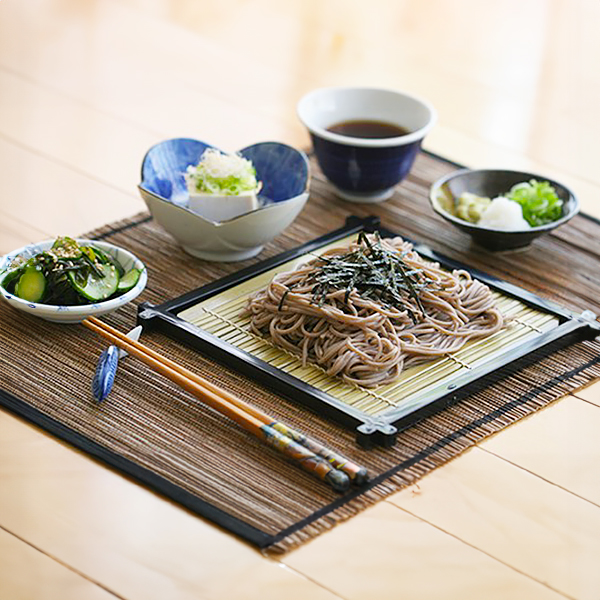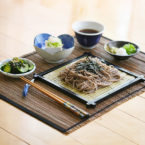Soba noodles are a delicious way to explore the authentic flavors of Japan. Simple but sophisticated, they are perfect for both lunch and dinner.
Soba noodles, one of the cornerstones of Japanese cuisine, are made from buckwheat flour, which gives them a characteristic nutty flavor and firm texture. Traditionally enjoyed cold with a dipping sauce or in a hot broth, they are not only mouthwateringly tasty, but also packed with nutrients.
These deliciously earthy strands have a rich history that dates back to the Edo period (1603-1868) in Japan. Initially considered a luxury, soba became popular among the masses for its nutritional value and its ability to prevent beriberi, a disease caused by vitamin B1 (thiamine) deficiency, thanks to its buckwheat composition.
The tradition of eating soba originates from the belief that the slender noodles symbolize a long and healthy life. Soba is traditionally served in various styles: like here, chilled with a dipping sauce (Zaru Soba), in a hot broth as a noodle soup, or stir-fried. It’s especially consumed during the New Year’s Eve celebrations in Japan, a customknown as Toshikoshi Soba, symbolizing the cutting away of the old year’s misfortunes.
Begin by picking up a few strands of noodles with your chopsticks, then dip them lightly into a cold tsuyu sauce—a savory blend of dashi, soy, and mirin. Avoid soaking; a gentle dip enhances flavor without overpowering the soba’s delicate taste.
Between bites, cleanse your palate with a sip of tsuyu or a bite of wasabi and green onions mixed into the sauce. It’s a refreshing, interactive meal, deliciously simple and elegant.
Don’t forget to slurp—it’s a compliment to the chef (yourself)!

How to Make Zaru Soba – Cold Japanese Noodles
Preparing the Soba Noodles:
- Boil Water: Fill a large pot with 2 quarts of water and bring it to a rolling boil over high heat.
- Cook Noodles: Carefully add the soba noodles to the boiling water, spreading them out. Stir gently to ensure they do not stick together. Wait for the water to return to a full boil, then lower the heat slightly to maintain a steady but gentle boil. Cook according to the package instructions, usually about 4-8 minutes.
- Cold Water Shock: If the noodles start boiling over, add a cup of cold water to lower the temperature briefly. This technique, known as ‘yudane’, helps to cook the noodles evenly.
- Check Doneness: Taste a noodle or check its texture; it should be firm yet tender, not mushy.
- Rinse and Cool: Once cooked, pour the noodles into a colander and rinse them thoroughly under cold running water. This stops the cooking process and removes excess starch, ensuring the noodles are cool and firm.
- Drain Well: Shake off the excess water and transfer the noodles to a tray. Cover with a damp kitchen towel to prevent them from drying out while you prepare the other components.
Preparing the Dipping Sauce (Tsuyu):
- Dashi Stock: Dashi is a fundamental Japanese stock often made from kelp (kombu) and dried bonito fish flakes (katsuobushi). For beginners, instant dashi granules are a practical choice. Follow the package instructions to prepare 1 1/2 cups of dashi. Typically, you’ll dissolve about 1 teaspoon of granules in 1 1/2 cups of hot water.
- Combine Ingredients: In a medium saucepan, mix the prepared dashi, soy sauce, mirin, and sugar. Place over medium-high heat and stir until the sugar dissolves. Remove from heat and let the sauce cool down. You can refrigerate it for a refreshing, cold dip.
Arranging the Dish:
- Nori and Garnishes: Cut the nori sheet into thin strips using kitchen scissors. Chop the green onions finely and prepare wasabi paste by mixing the wasabi powder with a little water. Let it stand to develop its flavor.
- Serve: Place the cooled noodles on individual plates or a communal serving dish. Sprinkle nori strips over the noodles. Serve the dipping sauce in small bowls or cups, and provide wasabi, grated daikon, and green onions on the side for guests to add according to their taste.
- Enjoy: Traditionally, diners will add their preferred garnishes to the dipping sauce, then dip small bundles of soba into the sauce as they eat. Slurping is encouraged — it enhances the flavors and cools the noodles!
Recipe Notes:
- If you’re unable to find dashi granules, a simple soy sauce and water mixture can be a base substitution for the dipping sauce, though it won’t have the same depth of flavor.
- Be careful not to overcook the soba noodles, as they can become mushy quickly.
- Adjust the wasabi and garnishes according to your personal preference for spice and flavor.

Zaru Soba – Cold Japanese Noodles
- Total Time: 35 minutes
- Yield: 4 servings 1x
Description
Soba noodles, a cornerstone of Japanese cuisine, are made from buckwheat flour, which gives them a characteristic nutty flavor and firm texture. Traditionally enjoyed cold with a dipping sauce or in a hot broth, they are not only delicious but also packed with nutrients. Soba have a special place in Japanese food culture, often eaten during celebrations or as a year-end meal to welcome the New Year.
Ingredients
- 2 quarts (8 cups or about 1.9 liters) Water
- 12 oz (340 g) Dried Soba/Buckwheat Noodles
- 1 1/2 cups (360 ml) Dashi Stock
- 5 tablespoons Soy Sauce
- 3 tablespoons Mirin (Japanese sweet cooking wine)
- 1 tablespoon Sugar
- 1 sheet Toasted Seaweed (Nori), cut into thin strips
- 2 Green Onions (Scallions), finely chopped
- 4 teaspoons Wasabi Powder (mix with water to form a paste)
- 2 teaspoons Grated Daikon (Japanese Radish)
Instructions
Preparing the Soba Noodles:
- Boil Water: Fill a large pot with 2 quarts of water and bring it to a rolling boil over high heat.
- Cook Noodles: Carefully add the soba noodles to the boiling water, spreading them out. Stir gently to ensure they do not stick together. Wait for the water to return to a full boil, then lower the heat slightly to maintain a steady but gentle boil. Cook according to the package instructions, usually about 4-8 minutes.
- Cold Water Shock: If the noodles start boiling over, add a cup of cold water to lower the temperature briefly. This technique, known as ‘yudane’, helps to cook the noodles evenly.
- Check Doneness: Taste a noodle or check its texture; it should be firm yet tender, not mushy.
- Rinse and Cool: Once cooked, pour the noodles into a colander and rinse them thoroughly under cold running water. This stops the cooking process and removes excess starch, ensuring the noodles are cool and firm.
- Drain Well: Shake off the excess water and transfer the noodles to a tray. Cover with a damp kitchen towel to prevent them from drying out while you prepare the other components.
Preparing the Dipping Sauce (Tsuyu):
- Dashi Stock: Dashi is a fundamental Japanese stock often made from kelp (kombu) and dried bonito fish flakes (katsuobushi). For beginners, instant dashi granules are a practical choice. Follow the package instructions to prepare 1 1/2 cups of dashi. Typically, you’ll dissolve about 1 teaspoon of granules in 1 1/2 cups of hot water.
- Combine Ingredients: In a medium saucepan, mix the prepared dashi, soy sauce, mirin, and sugar. Place over medium-high heat and stir until the sugar dissolves. Remove from heat and let the sauce cool down. You can refrigerate it for a refreshing, cold dip.
Arranging the Dish:
- Nori and Garnishes: Cut the nori sheet into thin strips using kitchen scissors. Chop the green onions finely and prepare wasabi paste by mixing the wasabi powder with a little water. Let it stand to develop its flavor.
- Serve: Place the cooled noodles on individual plates or a communal serving dish. Sprinkle nori strips over the noodles. Serve the dipping sauce in small bowls or cups, and provide wasabi, grated daikon, and green onions on the side for guests to add according to their taste.
- Enjoy: Traditionally, diners will add their preferred garnishes to the dipping sauce, then dip small bundles of soba into the sauce as they eat. Slurping is encouraged — it enhances the flavors and cools the noodles!
Notes
- Don’t overcook soba; they should be firm to the bite.
- Rinse noodles thoroughly to prevent a gummy texture.
- Adjust the dipping sauce’s flavor according to your preference.
- For a spicy kick, add more wasabi as desired.
- Prep Time: 15 mins
- Cook Time: 20 mins
- Category: Main Course
- Method: Boiling
- Cuisine: Japanese












Can’t find the instructions for making the noodles. Am I not looking at the right place?
Actually, this recipe is not for making the actual noodles, but for the accoutrements and dipping sauce.
Success! Felt like I was back in Japan with every bite. Thanks for sharing this gem!
Made a perfect dinner, and even my kids loved it. Thanks for introducing us to a new favorite.
Wow, this recipe turned out fantastic! It was my first time making Japanese cuisine, and I’m so proud of how it came out.
Made this for lunch today using your instructions – it was a hit! Even my skeptical roommate loved it. Thanks for the great recipe!
Massive success! The flavors were incredible, and the cold noodles were so refreshing!
Dear salt shaker,
Dashi is a type of fish broth sold in store that is also known as “Dashimoto” on the box. It asks specifically for that kind of fish brother becaus ethere are many kinds of broth.
Mirin is a flavor sauce (like soy sauce) that is used in japanese cooking. It’s unique, like Ketchup or Mayo, but the main ingredient is cornsyrup.
Wasabi is a very specific kind of spicy paste. Most wasabi sold out side of japan is an imitation because the actual plant has to be ground down and is difficult to cultivate.
If you hold down your CTRL key and press the + key, you can increase the font size of many websites and computer screens.
it also sound slike you may be confused on the specific of the recipe. Soba is specific kind of buckwheat noodle, much like Nori is a specific kind of seaweed, and Daikon is a specific variation of a radish. It’s a little like cooking Italian pasta. If a recipe said Spaghetti, it would not have the same results the same if you substituted spaghetti with ravioli or puttenesca or fettucini.
The dipping sauce was perfection. My family’s new favorite, thank you!
OMG, it’s delicious! The cold noodles are perfect for summer. This will be a regular in my meal rotation!
Never knew cold noodles could taste so good. Thanks for the clear instructions.
I AM NOT YELLING, JUST VISUALLY IMPAIRED, ESPECIALLY ON THIS WEBSITE! I WAS GLAD THAT YOU LET US KNOW THAT SOBA IS BUCKWHEAT, NORI IS SEAWEED, AND DAIKON IS RADISH, BUT WHAT ARE DASHI, MIRIN AND WASABI? FOR THE UNLEARNED, THIS WOULD BE A GREAT PLACE TO HAVE LEARNED THOSE THINGS, TOO! JUST SAYING…
Thanks for this recipe … I just picked up some soba noodles and was feeling uninspired.
Hi Karen, nice to see you here. What a beautifully presented dish, I just love soba noodles.